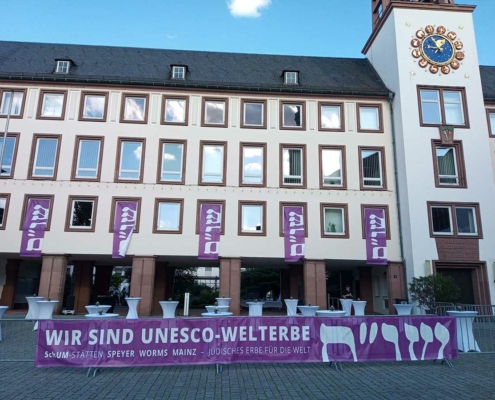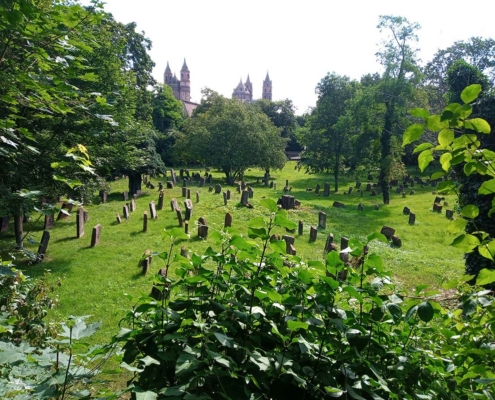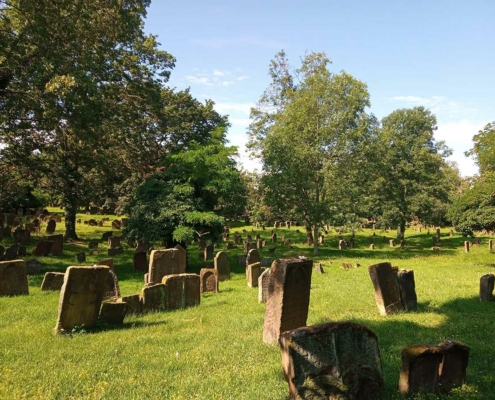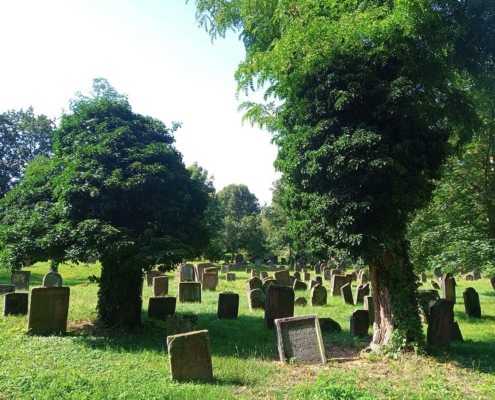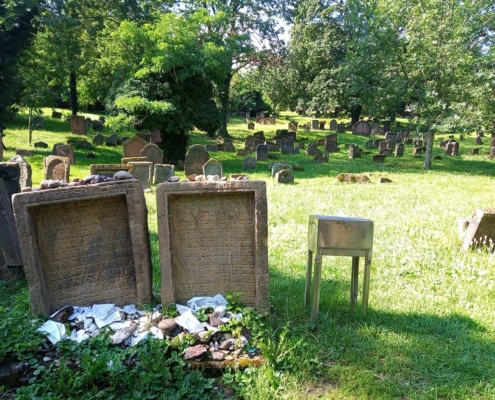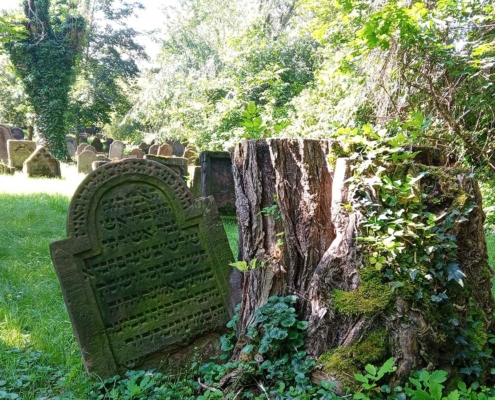The city of Worms and the Jewish UNESCO World Heritage
It has been official since 27 July 2021. The historical heritage of the Jewish communities in the cities of Worms, Speyer and Mainz has been part of the Unseco World Heritage since then. Under the name SchUM, the three cities joined forces many years ago to be included in the coveted list. It is not only the tourist aspect that drives the cities, but also recognition for their historical significance. SchUM is an abbreviation of the first letters of the medieval Hebrew city names of Speyer (Schpira), Worms (Warmaisa) and Mainz (Magenza). At the same time, the three cities are also considered the birthplace of “Ashkenazi Judaism”. This is understood to mean European Judaism. From around 960 AD onwards, wealthy families in particular were lured to the cities on the Rhine with the promise of reduced customs duties. While today Mainz is the mother community of the few Jews living in Worms, in the Middle Ages the significance was reversed. Numerous important scholars, such as Rabbi Meir von Rothenbur or the mystic Elasar ben Juda lived and taught in Warmaisa. Worms became Little Jerusalem, as it was reverently called by many Jews. The Jewish religious teacher Salomon Rothschild declared as early as 1905: “Worms is one of the cities of the Occident to which the most and most significant memories are attached for the history and literature of Judaism.” In 1849, Ferdinand Eberstadt, Germany’s first mayor of the Jewish faith, was elected in Worms. In the process, the popular politician had to assert himself against much opposition. In the Rhenish Treason Trial in July 1850, Eberstadt was accused of extortionate coercion as an “intellectual author”. In the autumn of the same year, however, he was acquitted. After his end in office as mayor in 1852, he was elected to the municipal council. Shortly afterwards, he was relieved of office by ministerial decree. The final end of Jewish history in Worms came with the National Socialists’ seizure of power. Today, around 60 Jews live in Worms, most of whom moved from Eastern European countries to the former Little Jerusalem in the 1990s. Meanwhile, the Rashi House is the home of Jewish history in Worms. The synagogue and the “Holy Sand” cemetery, meanwhile, are witnesses to the times that invite visitors to experience history.
An overview of the “SchUM happenings” can be found on the homepage:
You should have seen this in Worms / Warmaisa:
Holy Sand
Almost inconspicuous, it lies on the edge of the city centre, the oldest surviving Jewish cemetery in Europe, the “Holy Sand”. Bordered by a railway line and a main road, it is hard to imagine at first glance that behind the mighty grey walls lined with trees lies an inner-city oasis of peace and at the same time a place of worship. Triangularly laid out, the cemetery fascinates with a peculiar mixture of enchanted garden and monolithic contemporary witness. Scattered over gently rolling land are 2,500 gravestones, the oldest of which dates back to 1074 AD. When visiting this historic site, it is essential to pause at the “Martin Buber View”. From there you have a majestic view over the cemetery, while in the background the approximately 1000-year-old Worms Cathedral of St. Peter towers majestically over everything, as if keeping a watchful eye on the Jewish neighbourhood. Those who want to be inspired not only by the magical atmosphere of this extraordinary place can take one of the numerous guided tours offered by the city or download the SchUM app, which doesn’t just deal in knowledge, but puts faces to the gravestones. The cemetery, whose stones are unusually aligned from north to south, is not simply a historical document of days long past, but also enjoys an extremely prominent significance as a place of pilgrimage for Jews from all over the world. To this day, religious Jews come to Worms for the Holy Sand. Just beyond the wooden entrance gate, to the left of the path, the graves of the medieval rabbi Meir von Rothenburg and his disciple Alexander ben Salomon Wimpfen have become veritable pilgrimage sites. Countless paper notes with messages and petitions gather under small stones. For some time now, due to the quantity of notes, a letterbox has been set up next to the grave, which is around 1000 years old. Incidentally, men are asked to wear a head covering when entering the resting place.
Synagoge, Mikwe, Frauenschul
The former Jewish quarter of the city is located in the old town, more precisely in Judengasse. A narrow cobblestone street just two minutes’ walk from the Nibelungen Apartments. Here, too, the destruction of the city in 1689 and 1945 has left its mark. New buildings from the 1980s nestle against the medieval city wall that marks the north of the former city boundary. The 80s buildings repeatedly alternate with buildings whose origins date back to the 19th century. In the middle of this street or alley is the synagogue. Worms is not only home to the oldest burial place of the Jewish faith in Europe, but also to the synagogue, which was completed in 1034. It is not only a place of interest, but is now also used as a place of prayer again. The synagogue can look back on an eventful history, which was also marked by pogroms. It was repeatedly destroyed and rebuilt. In 1938, for example, it was burnt down by the National Socialists, only to be reopened in 1961. The prayer house also includes the first surviving women’s school, which was added to the synagogue in 1212/1213. Also included are the mikvah, the Jewish bathhouse, which was completed in 1186, and the foundations of the former community house, on which the Rashi House now stands with its exhibition on the life of the Jewish community in Worms. The synagogue grounds cannot be visited at present, as fundamental renovation work is taking place there.
Raschi-Haus
On the site of today’s functional building was an influential Talmud school in the Middle Ages, the Rashi Teaching House. Named after its teacher Rabbi Shelomo ben Jichaki, today the property houses the Worms City Archives as well as the Rashi House, the Jewish Museum of the City of Worms. Numerous pictures, handwritten or typed documents take visitors on a journey through the eventful history of Worms’ Jews. Sometimes persecuted, sometimes esteemed, Hitler’s National Socialists ensured that there was no longer a Jewish community in Worms after the Second World War. Meanwhile, the museum bears witness to how glorious and proud the thousand-year-old community once was. The museum is open Tuesday to Sunday from 10am – 12.30pm & 1.30pm – 5pm. General distance and hygiene regulations apply in the museum, which is why currently only 15 people can visit the museum at a time.
Link: www.worms.de/juedisches-museum/
Excursion destinations Speyer and Mainz
Speyer (Schpira)
Speyer is about 50 minutes south of Worms by car and can be reached easily from Worms via the motorway and the main road. The site is accessible from the street on the cathedral side through the Schpira Museum, which displays gravestones, double-arched windows and fragments of the medieval synagogue in a relatively small exhibition area. The remains of the synagogue can be seen in the form of preserved walls, the adjacent women’s school and the yeshiva, which has been preserved as an archaeological monument. In the centre of the former Jewish quarter (“Judenhof”) is the impressive building of the mikveh from around 1120. The Romanesque ritual bath is the oldest preserved of its kind in Europe. You have to descend about eleven metres into the cool darkness before you come upon the actual bathhouse. When compared, the mikvah in Worms feels like the small “role model” that served as a model, but was to be surpassed at all costs. The mikvah and its facilities were a central place for the Jews in Speyer until the dissolution of the community in the first third of the 16th century.
Mainz (Magenza)
The state capital Mainz, the third city in the alliance, north of Worms also about 50 kilometres away, has the fewest architectural monuments to show. Numerous wars have reduced the haptic heritage to a minimum, including a synagogue. The synagogue in Mainz-Weisenau was built in 1737/38. It is the only synagogue in Mainz to have survived the Nazi period and bombing raids and is the oldest surviving building in Weisenau. As the Weisenau Jewish community accounted for almost a quarter of the village population in the 18th century, the synagogue was built on Wormser Straße. Parts of the “Jewish cemetery” have also been preserved. The oldest part dates back to 1286 and, like the Worms cemetery, it is also located on a main road. While in Worms this fact is quickly forgotten, in Mainz it is difficult to ignore. Cars roar noisily around during the day, creating a contrast that couldn’t be starker.
Linktipp: www.förderverein-synagoge-mainz-weisenau.de
App-Tip
The app offers a tour of the Judenhof in Speyer, the old Jewish cemetery “Heiliger Sand” in Worms and the synagogue district in Worms. In addition, the app explains with fascinating stories what SchUM, the architecture of synagogues, women’s rooms and ritual baths are all about – and why Jewish cemeteries are “places of eternity”. Four different stories tell of Jewish history and its significance for the present. Whether Abel and Anton, Maayan or Rebecca and David – the protagonists are inquisitive, eager to discuss and love history. The user can choose between listening and reading. The app is also enriched with many pictures. Furthermore, there is additional information on opening hours, regulations for visiting, among others, a synagogue and a Jewish cemetery, tourist tips and information on restaurants. Supported languages: German and English.
www.schumstaedte.de/schum-app/
Book tip
Jerusalem am Rhein
Of course, one can make history one’s own in the usual way via informative websites or in the classical way with the help of specialised literature. But you can also make history comprehensible through stories. This is done wonderfully in the book “Jerusalem am Rhein”. Karl E. Grözinger, professor of religious studies and Jewish studies, has compiled numerous stories, legends, sagas and also everyday stories for this book. Sorted into eight chapters (e.g. “Wormser Wundermänner und Magier” or “Aus den Gerichtsstuben”), he has historically authenticated personalities describe their respective times / experiences. Sometimes this is humorous, sometimes it is sad, but the stories always unite to make the reader aware of this time and thus to get a feeling for the importance of the three cities. History lessons can hardly be more entertaining.
Jüdische Geschichten aus Speyer, Worms und Mainz
Von: Grözinger, Karl E.
Worms-Verlag, 2018, 256 Seiten, 60 Abb., 16 x 24 cm, kartoniert I 26 Euro
ISBN: 978-3-944380-83-4
Link: www.wormsverlag.de


